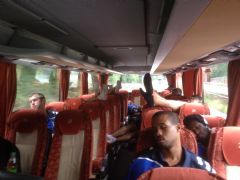The question is how do you measure the load & how do you measure the quality & amount of recovery that the athlete is getting?
In the age of big data, collecting information on the nature & amount of load can be relatively easy. GPS systems, allied with accelerometers & gyroscopes can measure distance, speed, acceleration, deceleration, vertical displacement & rotational movement, whilst heart rate data can be combined to evaluate the physiological effects of the work done. In fact, the bigger problem is collecting too much data & not knowing what to or how to interpret it to get useful information.
The costs of these systems, both in terms of initial outlay & also in terms of staffing costs to employ the people to digest the data is prohibitive for smaller teams, however. So how else can you measure load?
The team I am currently advising, are in real terms, a very new team - the brand is old but the new owners only bought the team a year ago & the infrastructure is in a very embryonic state. As a result, they don't have the resources or inclination as yet to opt for GPS systems or even heart rate monitors initially. As a result, the idea is to time sessions, use RPE (ratings of perceived exertion) scales to gauge intensity & carefully record components of each session, which in terms of conditioning work will include tasks such as calculating foot contacts & working out load data from the reps, sets & weights of any lifting work done.
Borg, G. (1975). Perceived exertion as an indicator of somatic stress. Scand J Rehabil Med; 2: pp92-98
The back to basics idea, in my opinion, is a great place to start because it gets coaches & conditioning staff talking the same language, whilst making everyone really reflect on the content of their sessions. Furthermore, it makes everyone realise that collecting data takes effort & time, so that you prioritise what data you collect & how you then use it. The default adopted is one of collecting data that is useful rather than collecting data for the sake of it.
On the recovery side, again, the technology available is extensive & in certain cases, expensive. OmegaWave machines, sleep monitors, FitLight systems, force plates & iris monitors are littering the science departments of many a big club but the data that I have seen collected doesn't necessarily find a correlation between cost & usefulness of data in reliably assessing recovery state & predicting detrimental performance states or increased risk of injury.
The ability to effectively measure the quality of recovery from training & traveling is critical though, so the back to basics approach that we intend to use initially will rely on using RPE & hydration data from training sessions, allied to the Groningen Sleep Score, the RESTQ (Sport) Recovery questionnaire & a Borg scale of evaluating muscle soreness. Low tech, low time constraints & useful enough in guiding how each individual is recovering from the sessions they are exposed to. Add to that a couple of goniometers & a jump mat to evaluate changes in joint range of movement alongside changes in muscle performance & we will cover most of the bases very satisfactorily.
Borg, G. (1998). Borg's perceived exertion & pain rating scales. Champaign, IL: Human Kinetics.
Meijman, T. et al (1985). The construction & evaluation of a one-dimensional scale measuring subjective sleep quality. Heijmans Bulletins, Psychologische Instituten, Groningen.
Once we can be confident we are doing the simple, cost effective & efficient assessments well & the players are complying with the new approach to monitoring, then we can start to look at the next step. However, in the first instance, I am looking forward to going back to basics!!!

